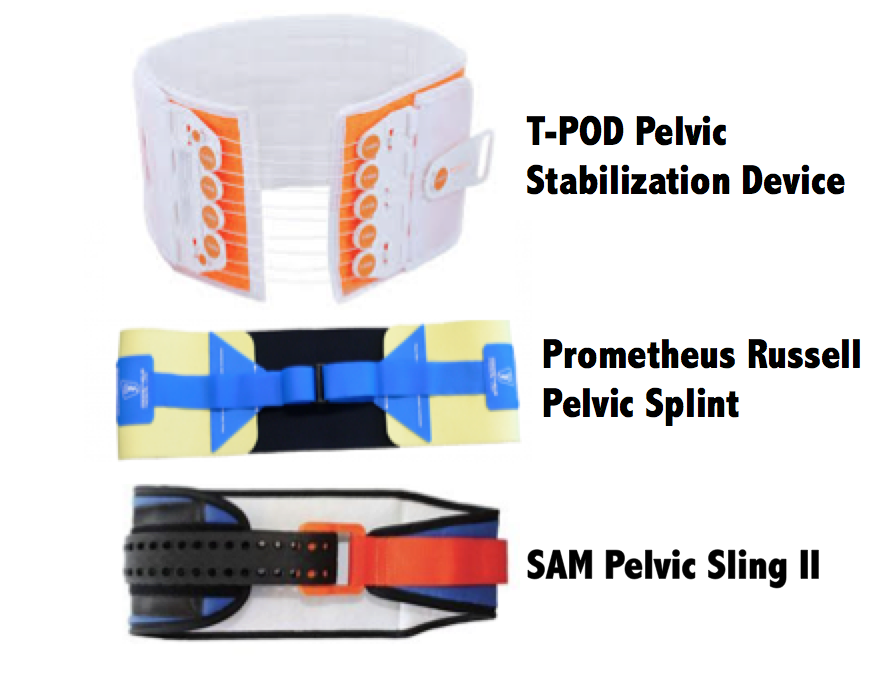
The other splints had similar pressures.Īnd finally, the price! Although your results may vary due to your buying power, the SAM sling is about $50-$70, the Pelvic Binder $140, and the T-POD $125.īottom line: The binder that performed the best (equivalent biomechanical testing, better tissue pressure profile) was the SAM sling. Once again, the Pelvic Binder pressures were higher.

Pressures over the trochanters decreased significantly after transfer to a hospital bed, but the Pelvic Binder pressures remained at the tissue damage level.It was highest with the Pelvic Binder and lowest with the SAM sling. All binders exceeded the tissue damage threshold at the greater trochanters and sacrum while lying on a backboard.The tissue damage threshold was assumed to be 9.3 kPa sustained for more than 2-3 hours based on the 1994 paper cited below.The 80 volunteers were outfitted with a pressure sensing mat around their pelvis, and readings were taken with each binder in place. So what about harm? A healthy volunteer study was used to test each binder for tissue pressure levels. The SAM sling limits compression to 150 Newtons, which was more than adequate to close the pelvis. Pulling force to achieve complete reduction was lowest with the T-POD (40 Newtons) and highest with the SAM pelvic sling (120 Newtons).


But biomechanical studies can serve as a surrogate to try to answer this question. It’s difficult to determine how well binders work in the live, clinical setting. There are a number of factors to consider when choosing one of these products. Today, I’ll go through the (little) science there is regarding which are better than others. JACS 204:935-942, 2007.Yesterday, I detailed some pelvic binders commonly available in the US. Reference: Emergent pelvic fixation in patients with exsanguinating pelvic fractures. Tomorrow: what’s the “best” pelvic binder? If not, apply the sheet, which will be described tomorrow with other binders. If you have a real POD in your ED or your ambulance, use it. It’s really cheap, but probably a bit less controlled than a POD. But does a sheet count as an orthotic device? We don’t know. This technique is simple, cheap and quick, an ideal combination. Use of a pelvic orthotic device (POD) resulted in less blood replacement and shorter stays in hospital.

There was no difference in mortality.īottom line: Although this is a small, retrospective study it easily showed significant results and will probably never be repeated. Hospital length of stay was also significantly shorter in this group (17 vs 24 days). About a quarter of patients in each group went to angiography, and even in those patients the transfusion need remained lower in the orthotic device group. The authors found that transfusion needs were dramatically reduced with the orthotic devices (5 units vs 17 units at 24 hours) compared to the orthotics. They ultimately analyzed outcomes for 93 patients in each treatment group. Stabilization consisted of external fixation early on, and gradually shifted to pelvic orthotic devices over the study period. A study from Memphis finally sheds some light on the answer to this question.Ī 10 year retrospective review was carried out on patients presenting with multiple or severe pelvic ring fractures who had early stabilization of the pelvis. But the idea that external fixation was the most desirable or most effective lingered on. High volume trauma centers with ortho residents could actually pull this off, but not many others.Īs the idea of pelvic orthotic binders caught on (T-POD, sheeting, etc) and was adopted by prehospital providers, and then trauma teams, the use of initial external fixation dropped off. In some textbooks, it was even suggested that this should be done (by orthopedics) in the resuscitation room. In the “old” days, the recommended management for an unstable pelvis like these was application of an external fixator. Yesterday, I wrote about the open book, A-P compression mechanism, pelvic fracture.


 0 kommentar(er)
0 kommentar(er)
